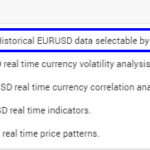The EUR/USD pair has experienced a significant surge, reaching the 1.0560 level on Tuesday, marking a new high for the year. This upward movement is primarily attributed to the continued weakening of the US Dollar (USD). The Dollar Index (DXY), a measure of the USD’s strength against a basket of currencies, fell below 106.00, a level not seen since early December. This article delves into the factors driving this EUR/USD rally, providing essential EUR/USD news and analysis for traders and investors.
Tariffs, Geopolitics, and Market Mood: Key Influences on EUR/USD
The recent implementation of tariffs by the United States has introduced a layer of complexity to the global economic landscape, impacting currency valuations including EUR/USD. President Trump’s imposition of 25% tariffs on goods from Canada and Mexico, alongside 20% tariffs on Chinese imports, has triggered retaliatory measures. China, Canada, and Mexico have responded with their own tariffs on US goods, escalating trade tensions.
These trade disputes can influence currency markets in several ways:
- Inflationary Pressures: Tariffs can lead to higher import costs, potentially fueling inflation. If inflation rises, the Federal Reserve (Fed) might adopt a more hawkish monetary policy, which typically strengthens the USD.
- Economic Slowdown Concerns: Conversely, tariffs can hinder economic growth by increasing costs for businesses and consumers. Slower growth could prompt the Fed to become more dovish, weakening the USD.
From a Eurozone perspective, the threat of US tariffs on European Union goods poses a downside risk to the Euro, potentially pushing the EUR/USD pair lower.
However, amidst these trade concerns, positive geopolitical developments have emerged. Reports suggesting progress towards a potential peace agreement in the Russia-Ukraine conflict have boosted market sentiment. This optimism has provided a lift to riskier assets and contributed to the EUR/USD’s upward momentum, especially following reports of strained relations between President Trump and President Zelenskyy at a recent White House meeting.
Central Bank Policies in Focus: Fed and ECB Divergence
Central bank policies are pivotal in shaping currency valuations. The Federal Reserve recently maintained its policy rate at 4.25%–4.50%, reflecting confidence in the US economy’s solid growth, stable inflation, and robust labor market. Fed Chair Jerome Powell has consistently indicated that it is premature to consider interest rate cuts, citing persistent inflationary pressures and strong employment data. The Fed is also closely monitoring the potential inflationary impact of trade disputes, which could complicate inflation management.
Across the Atlantic, the European Central Bank (ECB) is widely anticipated to cut its key interest rate by 25 basis points on Thursday. This expected rate cut is aimed at stimulating the sluggish eurozone economy. ECB President Christine Lagarde has signaled a cautious approach, resisting calls for a more aggressive 50-point cut and emphasizing data dependency. Lagarde remains optimistic that inflation will return to the ECB’s target by 2025, suggesting that any further monetary easing will be gradual.
EUR/USD Short-Term Outlook: Navigating Uncertainty
The EUR/USD pair’s trajectory in the short term remains heavily influenced by evolving trade policies, diverging central bank strategies between the Fed and ECB, the Eurozone’s economic challenges, and political developments within Germany and the broader geopolitical landscape. Until greater clarity emerges regarding tariffs and a more definitive direction is signaled by both the Federal Reserve and the European Central Bank, the EUR/USD pair is likely to continue trading within a relatively confined range. Monitoring EUR/USD news closely will be crucial for traders seeking to navigate this period of uncertainty.

